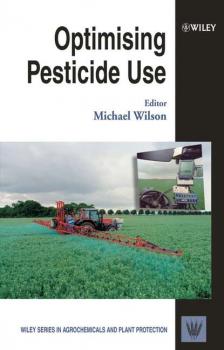Michael Wilson
Список книг автора Michael WilsonOptimising Pesticide Use
Optimising Pesticide Use brings together the wide range of scientific disciplines necessary to ensure best practice through monitoring what is used and improving how it is formulated and applied. The book provides: An in-depth exploration of pesticide optimisation from the view point of industry and research scientist A case study on the development of a new range of active chemistries from bacteria A discussion of complementary pest control methods This text will provide essential information to workers in the pesticide industry and regulatory community who need to be aware of current thinking and advancements in the optimal use of pesticidal compounds and systems, as well as environmental organisations and aid development organisations.
Bacteriology of Humans
1st Prize, 'New Authored Books' category, Royal Society of Medicine and Society of Authors Medical Book Awards 2008 “Overall, I am impressed by the up-to date information content and structure provided in Bacteriology of Humans. It is truly an ecological perspective helpful for undergraduate/graduate majors in microbiology and immunology.” –American Society for Microbiology, June 2009 «Wilson provides the reader with an up-to-date, comprehensive census of the indigenous microorganisms that inhabit the human body and in so doing contributes significantly to this rapidly advancing area of study. The narrative is clearly written; the index is excellent; there are numerous bibliographic citations. Each chapter is rich with tables, diagrams, color micrographs, and charts … Highly recommended.» –Choice Reviews «This comprehensive, yet accessible text… is an excellent and informative reference book… it should be on the shelf of every major science and medical library. The content, organization, and presentation make this book a unique resource.» –Doody's Book Reviews Until recently, the indigenous microbiota of humans has been a relatively neglected area of microbiology with most attention being focused on those microbes that cause disease in humans, rather than on those that co-exist with us in the disease-free state. However, in the past decade research has shown that not only is the indigenous microbiota involved in protecting humans from exogenous pathogens but it is also involved in our development and nutrition. Consequently, interest has grown substantially among health professionals and scientists in analyzing and understanding these microbial (largely bacterial) communities. This comprehensive, yet accessible text provides an up-to-date guide to the development, composition and distribution of indigenous microbial communities of humans. With the aid of abundant colour figures, diagrams, tables and maps, it establishes links between the physicochemical factors prevailing at an anatomical site and the types of microbes to be found there. The book includes an introduction to the human-microbe symbiosis as well as an in-depth look at the main systems and organs of the human body that have an indigenous microbiota. Each chapter includes a list of references for further study. This is an excellent and informative reference book that is useful to anyone with an interest in microbiology, medical microbiology, microbial ecology, infectious diseases, immunology, human biology, medicine, dentistry, nursing, health sciences, biomedical sciences or pharmacy – it should be on the shelf of every major science and medical library. Hallmark Features: Provides a comprehensive, yet accessible, reference book on the human microbiota Lavishly illustrated with colour figures, diagrams, tables and maps Each chapter provides a list of references to promote further study Each chapter contains links to key websites Offers an ecological approach that explains why certain organisms are associated with a particular anatomical site
Londons Grand Guignol and the Theatre of Horror
A companion to UEP’s Grand-Guignol: The French Theatre of Horror (now in its third reprint). A genre that has left more of a mark on British and American culture than we may imagine” (Gothic Studies). London’s Grand Guignol was established in the early 1920s at the Little Theatre in the West End. It was a high-profile venture that enjoyed popular success as much as critical controversy. On its side were some of the finest actors on the English stage, in the shape of Sybil Thorndike and Lewis Casson, and a team of extremely able writers, including Noël Coward. London's Grand Guignol and the Theatre of Horror considers the importance and influence of the English Grand Guignol within its social, cultural and historical contexts. It also presents a selection of ten remakarble English-language Grand Guignol plays, some of which were banned by the Lord Chamberlain, the censor of the day, and have never been published or publicly performed. Among the plays in the book is a previously unpublished work by Noël Coward, The Better Half , first performed at the Little Theatre in 1922. The reviewer in the journal Gothic Studies wrote, of the authors’ previous book: “having recently taught a module on Grand Guignol with third year drama students, it is also worth noting that this book captured their imaginations in a way that few other set texts seem to manage.”
Grand-Guignol
The Théâtre du Grand-Guignol in Paris (1897 – 1962) achieved a legendary reputation as the 'Theatre of Horror' a venue displaying such explicit violence and blood-curdling terror that a resident doctor was employed to treat the numerous spectators who fainted each night. Indeed, the phrase 'grand guignol' has entered the language to describe any display of sensational horror. Since the theatre closed its doors forty years ago, the genre has been overlooked by critics and theatre historians. This book reconsiders the importance and influence of the Grand-Guignol within its social, cultural and historical contexts, and is the first attempt at a major evaluation of the genre as performance. It gives full consideration to practical applications and to the challenges presented to the actor and director. The book also includes outstanding new translations by the authors of ten Grand-Guignol plays, none of which have been previously available in English. The presentation of these plays in English for the first time is an implicit demand for a total reappraisal of the grand-guignol genre, not least for the unexpected inclusion of two very funny comedies.




